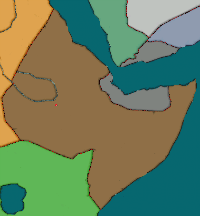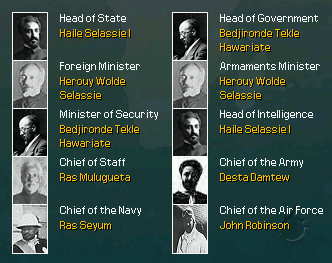Abyssinia
From Kaiserreich
| Line 72: | Line 72: | ||
==Military== | ==Military== | ||
===Army=== | ===Army=== | ||
| - | The Imperial Army was expanded after the end of the [[Weltkrieg]], however it still mainly composed by militias | + | The Imperial Army was expanded after the end of the [[Weltkrieg]], however it was still mainly composed by militias before the coronation of [[Haile Selassie I]]. When he ascended to power, he started a process of modernization of the army with the intent of bringing it up to the european standard. For this reason he created the Kebur Zabangna, the Imperial Guard based in [[Addis-Ababa]], trained by German military advisor and supplied with modern equipment. This elite unit was organized in three battalions of trained regular infantry armed with rifles, machineguns and mortars; it also had one heavy machine-gun company. |
| + | |||
| + | The Emperor also created his own military school at Holeta in January 1935 and invited military advisors from [[Flanders-Wallonia]]. | ||
| + | |||
===Navy=== | ===Navy=== | ||
Despite the annexation of Italian Somaliland and Eritrea and therefore of the ports of Massaua and Mogadishu, a serious military naval program was never attempted. | Despite the annexation of Italian Somaliland and Eritrea and therefore of the ports of Massaua and Mogadishu, a serious military naval program was never attempted. | ||
Revision as of 20:36, 27 November 2008
| ||||

| ||||
|
| ||||
| Official Language | Amharic | |||
| Capital | Addis-Ababa | |||
| Head of State | Haile Selassie I | |||
| Head of Government | Bedjironde Tekle Hawariate | |||
| Establishment - Traditional date | circa 980 BC | |||
| Government | Autocratic monarchy | |||
| Currency | Ethiopian birr | |||
| Area | Around 1.600.000 km² | |||
| Population | About 7 millions | |||
Abyssinia is a country in Africa. It borders Egypt to the north-west, Freistaat Mittelafrika to the south-west and it surrounds German Somaliland to the east.
Contents |
History
The overthrow of Iyasu V in 1916 created more problems than it solved, as when his aunt Zauditu ascended the throne she caved in to increasing pressure from the Progressive Party to make Ras Tafari Makonnen heir to the throne - a decision that would later prove to be a serious cause of trouble. Nevertheless, Abyssinia flourished under Zauditu, culminating in the country’s 1918 entry into the Weltkrieg on the side of Germany and the subsequent annexation of Italian Somaliland and Eritrea. Another sign of Abyssinia’s flourishing state of affairs was the expansion of the Addis Ababa-Djibouti railway into Freistaat Mittelafrika in 1925, which became the Deutsche Pan-Afrikanisches EisenBahn (DPAEB). The creation of this rail link initially brought relative prosperity to eastern Abyssinia, although lately it has shown signs of economic instability. In 1930 Empress Zauditu died and having left no surviving children Ras Tafari Makonnen ascended to the throne as Emperor Haile Selassie I without any significant problems. Upon climbing the throne the new Emperor started a series of sweeping political reforms to bring Abyssinia ‘into the west’. These reforms however were fiercely opposed by the conservative elements of the nation, who had been greatly strengthened by the annexation of the Italian colonies and the subsequent expansion of the army.
Politics
In 1936 the conservatives are growing increasingly restless over the reforms introduced by Emperor Haile Selassie I and the DPAEB is starting to experience major economic problems.
|
Negus Negast and Responsible for Military Intelligence: His Imperial Highness Haile Selassie I (born 23 July 1892)
Prime Minister and Minister of Interior: Bedjironde Tekle Hawariate
Minister of Foreign Affairs and Finance: Herouy Wolde Selassie
Minister of War: Ras Mulugueta
Commander-in-Chief of the Ethiopian Army: Desta Damtew (born 1898)
Commander-in-Chief of the Ethiopian Navy: Ras Seyum (born 21 June 1887)
Commander-in-Chief of the Ethiopian Army Air Service: John Robinson
Military
Army
The Imperial Army was expanded after the end of the Weltkrieg, however it was still mainly composed by militias before the coronation of Haile Selassie I. When he ascended to power, he started a process of modernization of the army with the intent of bringing it up to the european standard. For this reason he created the Kebur Zabangna, the Imperial Guard based in Addis-Ababa, trained by German military advisor and supplied with modern equipment. This elite unit was organized in three battalions of trained regular infantry armed with rifles, machineguns and mortars; it also had one heavy machine-gun company.
The Emperor also created his own military school at Holeta in January 1935 and invited military advisors from Flanders-Wallonia.
Navy
Despite the annexation of Italian Somaliland and Eritrea and therefore of the ports of Massaua and Mogadishu, a serious military naval program was never attempted.
Air Force
Abyssinia has a small and recently formed airforce, composed exclusively by interceptors.
Foreign relations
Friendly relations with Ireland, Germany, Freistaat Mittelafrika, Japan and Commune of France
Unfriendly relations with Italian Federation, South Africa, Republic of the Sicilies and Union of Britain


